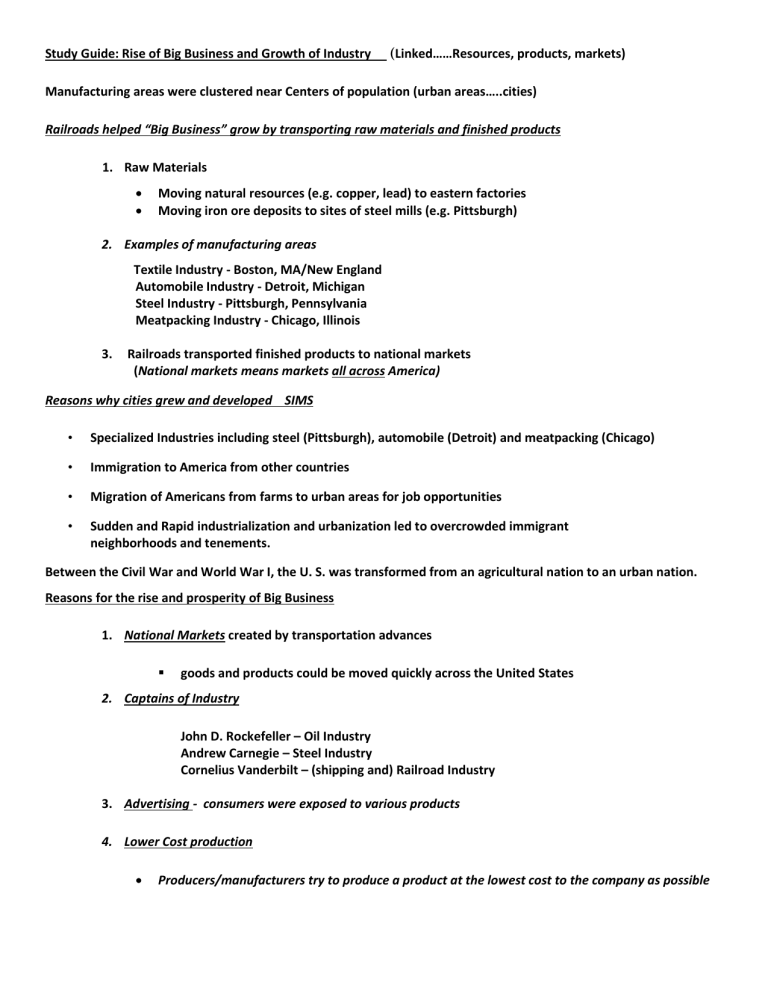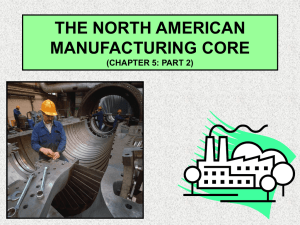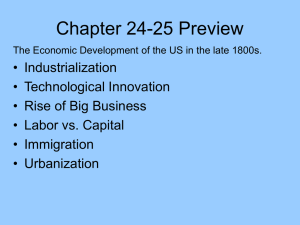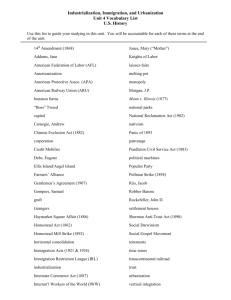Study Guide: Rise of Big Business and Growth of Industry ... Manufacturing areas were clustered near Centers of population (urban areas…..cities)

Study Guide: Rise of Big Business and Growth of Industry ( Linked……Resources, products, markets)
Manufacturing areas were clustered near Centers of population (urban areas…..cities)
Railroads helped “Big Business” grow by transporting raw materials and finished products
1.
Raw Materials
Moving natural resources (e.g. copper, lead) to eastern factories
Moving iron ore deposits to sites of steel mills (e.g. Pittsburgh)
2.
Examples of manufacturing areas
Textile Industry - Boston, MA/New England
Automobile Industry - Detroit, Michigan
Steel Industry - Pittsburgh, Pennsylvania
Meatpacking Industry - Chicago, Illinois
3.
Railroads transported finished products to national markets
(National markets means markets all across America)
Reasons why cities grew and developed SIMS
• Specialized Industries including steel (Pittsburgh), automobile (Detroit) and meatpacking (Chicago)
• Immigration to America from other countries
• Migration of Americans from farms to urban areas for job opportunities
• Sudden and Rapid industrialization and urbanization led to overcrowded immigrant neighborhoods and tenements.
Between the Civil War and World War I, the U. S. was transformed from an agricultural nation to an urban nation.
Reasons for the rise and prosperity of Big Business
1.
National Markets created by transportation advances
goods and products could be moved quickly across the United States
2.
Captains of Industry
John D. Rockefeller – Oil Industry
Andrew Carnegie – Steel Industry
Cornelius Vanderbilt – (shipping and) Railroad Industry
3.
Advertising - consumers were exposed to various products
4.
Lower Cost production
Producers/manufacturers try to produce a product at the lowest cost to the company as possible
Factors that resulted in growth of industry
• Access to raw material and energy
• Availability of work force due to immigration (and migration, but mostly immigration)
• Inventions
• Financial resources (money needed to start and run a business)
You’ve got MAIL: Postwar changes in farm and city life
• Mechanization (e.g. the reaper) reduced farm labor need and increased production. o Farms produced more, but it took less people to work the farm o People were replaced by machinery
• Access to consumer goods (e.g. mail order catalogs) due to Industrialization
• Mail order catalogs could reach remote towns and farms
• Instead of building stores in less populated areas, stores would send small towns and farms
their catalogs
• Products would be shipped in the mail
• Increased Labor in cities created by industrialization need
Midwest map
Detroit, Michigan
St. Louis, Missouri
Chicago, Illinois




